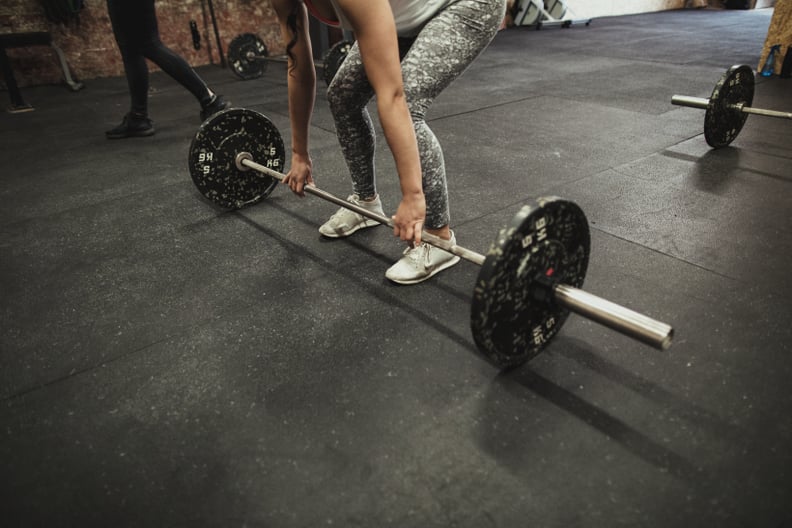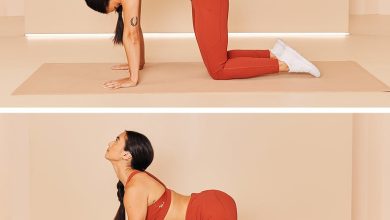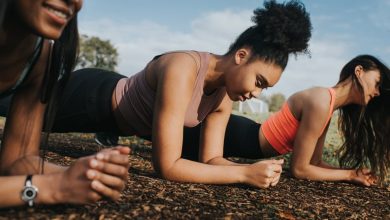Deadlifts Work More Muscles Than You Might Think — and the DOMS Will Prove It

When you describe a deadlift, the exercise sounds almost easy. All you have to do, after all, is pick up a weight from the floor, then put it back down. But as anyone who’s tried one knows, in practice, knowing how to do a deadlift exercise is pretty challenging. It’s hard to perfect your deadlift form, for one. It’s also quite the workout, as the DOMS will prove a day or two later.
To that point, when you do a deadlift, more muscles are worked than you might expect. “In a deadlift, the primary muscles used are the hamstrings, lats, glutes, erector spinae (lower back), and quads,” says Semaj Walker, a personal trainer. Most of the muscles engaged in a deadlift are in the posterior chain (back side) of your body, although your lats are also crucial for stabilizing the movement. “Strengthening the posterior chain helps balance out muscle development, reduces the risk of muscle imbalances, and improves overall functional strength,” Walker tells PS.
Here, more about the benefits of deadlifts and why you should add them to your strength-training program — plus, step-by-step instructions for how to do a deadlift, and how to adapt the move for your own personal fitness goals.
Expert Featured in This Article
Semaj Walker is a certified personal trainer through the American Council on Exercise (ACE) and based in Los Angeles.
Benefits of Deadlifts
- They’re a functional movement. Bending over to tie your shoes; cleaning the house; picking up your pup for a loving squeeze — all those daily activities require a hip hinge, a functional movement pattern that deadlifting mimics. “Having deadlifts in your training enhances your ability to perform day-to-day tasks in a safe and efficient manner,” Walker says. Trust us, you’ll see the payoff the next time you have to lift a heavy bag of groceries off the floor.
- They improve posture. To perform deadlifts safely, proper spinal alignment and core engagement are necessary. That said, deadlifts, when practiced regularly, strengthen stabilizer muscles in the spine, reinforcing good posture and spinal stability. And we know, that may not sound like a big payoff. But besides the fact that your parents have been bugging you to stand up straight for years, good posture can help you perform other exercises with proper, safe form, which is a huge advantage.
- They’re efficient. “Deadlifts recruit plenty of large muscle groups simultaneously which can cause the body to release growth hormones,” Walker says. It’s known as a compound exercise, and besides the fact that more muscles being recruited = a higher metabolic demand required, it also means more muscles are being strengthened at one time. Yes, that can lead to some major soreness the next day — but the strength gains are pretty major as well.
How to Do a Deadlift
Start with your bodyweight or a weight that is light enough to allow you to maintain proper form for 8 to 12 reps. Then, gradually increase the weight over time. Or, when performing multiple sets, add more weight to each set to challenge yourself.
- Stand with your feet hip width apart or slightly wider, and a barbell, a kettlebell, or two dumbbells, in front of you on the floor. Your feet should be close to the weights; even under the bar, if you’re using a barbell.
- Push your bottom back into a squat and hinge at the waist, bending your knees to grasp the weight in your hands.
- Squeeze the shoulders together slightly to engage your lats.
- Grounding your feet, pull the weight up, keeping the bar close to your body. As you come to stand, squeeze your glutes. (But avoid pushing your hips forward, arching your body.)
- To lower the weight, hinge at the hips, bringing your chest forward, while tracing the front of your thighs with your weights.
- As the weights pass your knees, bend your knees and continue hinging forward until the weights tap the floor.
Pro tip: Don’t skip step three! Lack of lat engagement is a common mistake people make when deadlifting, and can result in injury. Recruiting your lats will help keep your weights from drifting away from your body. Why that’s important: when the weight does drift, it sets off a whole cascade of undesirable moves that end with you shifting onto your toes and rounding your back — not good news for your body.
Deadlift Variations and Modifications
Slow Deadlift
You can add difficulty to any lift simply by slowing down. Moving at a slower rate on the eccentric (lengthening) part of an exercise will create more time under tension, or how long the muscle is being strained. In the case of a deadlift, you could slow down on the lift up or the hinge forward. Try to lengthen the movement so it spans a count of four.
Romanian Deadlift
This version of a deadlift is commonly seen among people using dumbbells instead of a barbell. A full description of how to do it is here, but you’ll start standing, holding your weights, then hinge forward to lower your weights to around knee level, stopping when you feel the stretch in your hamstrings.
Deadlift With Row
“When designing a training routine, incorporate accessory exercises such as hip thrusts and bent-over rows to strengthen key muscles involved in the deadlift. The stronger the main muscle groups recruited in a deadlift, the stronger the deadlift will be,” Walker says.
For instance, with a deadlift with row, you’ll add a bent-over row in when you’re in your hip hinge, at the “bottom” of your deadlift. Squeeze your shoulder blades together to row your weights back, then lower them and return to your standing position.
Glute Bridge
An exercise that will target some of the same muscle groups as the deadlift, but may be a better fit for some people, such as those with knee injuries, is a glute bridge. To perform a glute bridge, start by laying on your back with your feet flat on the ground. Brace the core and lift your hips until your body is in a diagonal line, then return to the starting position.
You can challenge yourself by holding a dumbbell over your pelvis while you lift up, or modify by resting your shoulders and upper body on an exercise ball while you perform the move.
Brittany Hammond is a NASM-certified fitness instructor, a fitness writer, and an avid reader. In addition to PS, she has contributed to Livestrong.com, Well+Good, Verywell Fit, and Health.com. She has worked as a group fitness coach for the past seven years.



